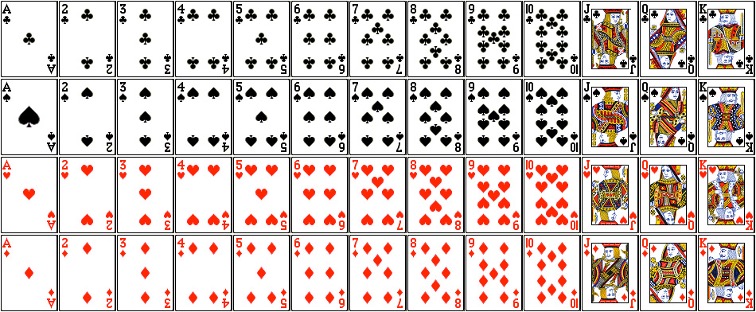Mathematics Homework Help
Grossmont College Module 14 Probability of Drawing a Random Sample Questions
You are studying with one of your classmates who is acing this class. She displays the following picture.

Then she pulls out a new deck of cards. She removes the plastic wrap from the deck of new cards, opens the box, and pulls out the cards. She removes the jokers and any other cards not displayed in the picture above. Then she starts shuffling the cards – which is difficult because the cards are brand new and slippery. She continues to shuffle and reshuffle until you agree that the deck is well-shuffled. Then she sets the deck down.
To verify that you know how to calculate various probabilities for a randomly drawn card, she asks the following questions which you answer correctly.
- If I randomly select a card, what is the probability of drawing a red card?
YOUR ANSWER: 26/52 = 0.5 or 50% - If I randomly select a card, what is the probability of drawing a 9?
YOUR ANSWER: 4/52 ?? 0.0769 or 7.69% - If I randomly select a sample of two cards, what is the probability that both cards are red?
YOUR ANSWER: (26/52)(25/51) ?? 0.2451 or 24.51% - In the above calculation you multiplied, (26/52)(25/51). Why?
YOUR ANSWER: Randomly selecting a sample of two cards means we draw two cards – one at a time without replacement. So a random sample of two red cards means the first card is red and the second card is red. When we randomly select the first card, the probability we draw a red card is 26 red cards out of 52 total cards, or 26/52. We set that first red card aside. So, when we randomly select the second card, there are only 25 red cards out of a total of 51 cards, so the probability we get a red card is 25/51. We need to calculate the probability that the first card is red AND the second card is red. So we multiply the two fractions together, (26/52)(25/51).
Then your classmate says, “O.K. Let’s make a little bet. If you draw a black card, I will help you with all remaining homework in this class.” If not, you must wash and wax my car for me. Since she opened a brand new deck of cards right in front of you and you verified they were well-shuffled, you know the probability of drawing a black card is 0.5 or 50%, so you agree to the bet.
She picks up the deck of cards, fans them out (face down of course), and asks you to randomly select a card. You select a card and turn it over. It’s red – not black.
You set the card aside and ask to try again. She reluctantly agrees and warns that if you lose, you will have to wash and wax her car twice. But if you win, you will not have to wash and wax her car, and she will help you with your homework as promised. You draw another card. It’s red – not black.
You set the card on top of the previously drawn red card and ask to try a third time. Again, she reluctantly agrees, and you draw another card. It’s red – not black. You must now wash and wax her car three times. You decide to quickly calculate the probability of randomly selecting a sample of three red cards.
2652?2551?2450?0.11762652?2551?2450?0.1176 or 11.76%
You set the card on top of the previously drawn red cards and think, “The next card has to be black.” You ask to try a fourth time. Again, she reluctantly agrees, and you draw another card. It’s red – not black. You now have a random sample of 4 red cards, and you must wash and wax her car four times.
You set the card on the stack of previously drawn red cards, and ask to try again. Once again, she reluctantly agrees, and you draw another card.
Prompt
- What is the probability of drawing a random sample of 4 red cards (write the probability as a decimal and a percentage)? Would you consider the random sample of 4 red cards unusual? Why or why not?
- What is the probability of drawing a random sample of 5 red cards (write the probability as a decimal and a percentage)? Would you consider the random sample of 5 red cards unusual? Why or why not?
- When your classmate began shuffling the deck of cards, what obvious assumption did you believe was true? If you draw a random sample of 5 red cards from the deck, should you reject that assumption? Why or why not?
- Based on your responses to the previous question, what will you infer about the deck of cards?

 Talk to us support@bestqualitywriters.com
Talk to us support@bestqualitywriters.com